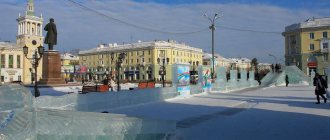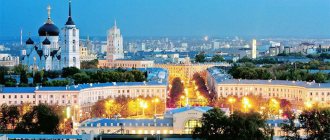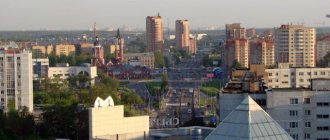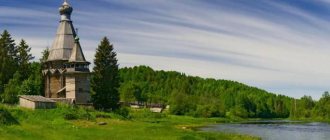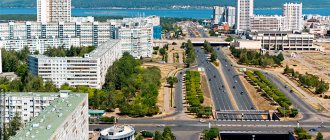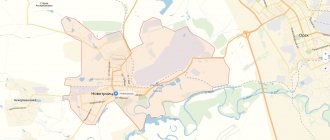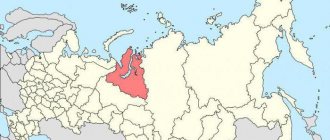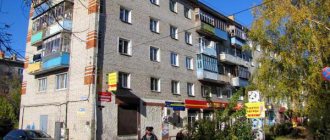The history of the city, or how Muscovites and Lithuanians did not divide Kaluga
Try to imagine the cradle of astronautics... If your imagination stands still or, on the contrary, gallops into the wilds of fantasy, then to compare your images with reality you need to go to Kaluga, where the ideas of conquering the cosmic depths were born and nurtured.
Monument to K.E. Tsiolkovsky in Peace Square
Of course, the ancient builders of Kaluga did not know the word “cosmonautics” and were not making a cradle, but were busy with purely earthly problems - protection from enemy raids. Believe it or not, in the 14th century the Kaluga land was constantly the cause of confrontations between the Moscow principality and the Lithuanian principality. Now it seems like a funny joke (where is Moscow, where is Kaluga and where is Lithuania?), but back then it couldn’t be more serious.
Otherwise, why would the Lithuanian prince Olgerd complain to Patriarch Philotheus himself in Constantinople that the Moscow princes of the city (including Kaluga) had taken it away from him? It is this complaint that dates the emergence of the city of Kaluga - 1371, although, of course, even before Olgerd’s letter, the Kaluga fortress already stood on the high bank of the Oka River, 190 kilometers southwest of Moscow.
Stele on the road ring
Before Kaluga acquired a space brand, it suffered many troubles and hardships: either from the Tatar-Mongols, whose yoke was ended in the vicinity of Kaluga after the Great Standing on the Ugra, or from the “pestilence”, which left fewer survivors thousands of Kaluga residents, then from a fire when all the wooden Kaluga burned out.
Monument in honor of the Great Standing on the Ugra
If you list numerous disasters, it will be difficult to stop, because only a tsunami is missing, and that is for the reason that the Kaluga Sea is just a reservoir, and Kaluga is located in a quiet seismic zone in the central part of Russia. Be that as it may, Kaluga survived and even in the 17th and 18th centuries was a very prosperous city. The city is still striving for a new state of prosperity.
Entrance to Kaluga from the Oka
Story
To this day, the cause and date of the emergence of the city of Kaluga remains a subject of debate among scientists and researchers. The official founding date of the city is considered to be 1371, the year of the first mention of Kaluga in written sources that have survived to our times. Even the first historians of the city of Kaluga noted that the city was much older than its official age. This version is confirmed by data from archaeological research in places of ancient settlements on the territory of modern Kaluga.
There were three medieval fortifications on the territory of the city: one at the mouth of the Kaluzhka River, at its confluence with the Oka, another upstream of the Kaluzhka, in the vicinity of the village of Zhdamirova, and the third, known as Semyonovo fortification, on the banks of the Yachenka River. The first excavations at the settlement at the mouth of the Kaluga were carried out at the end of the 19th century. archaeologist I. D. Chetyrkin, who discovered traces of a fire and remains of pottery on it. Subsequent excavations showed that two settlements on Kaluzhka had existed since ancient times.
The oldest historian of Kaluga, academician V.F. Zuev, who lived in the 18th century, recorded a legend according to which Kaluga was moved to a new place three times, and he also considered the first place to be a settlement at the mouth of Kaluga.
In the 13th – 14th centuries, the Kaluga lands were part of one of the Verkhovsky principalities, Novosilsky or Tarussky. From the middle of the 14th century, Kaluga became the object of struggle between Moscow and Lithuanian princes.
Kaluga local historians and independent researchers of the history of the Kaluga region put forward a version about the emergence of Kaluga as a Tatar-Mongol administrative and tax center during the formation of the Baskas in Rus',
however, this hypothesis has not yet been reflected in authoritative sources recognized by the scientific community.
In 1371, the borders of the Moscow Principality came close to the territory of modern Kaluga. Historian V.N. Temushev Fr.
The Lithuanian princes believed that Kaluga was unfairly “taken from them by Moscow.” The first written mention of Kaluga is connected with this, which is contained in a letter from the Lithuanian prince Olgerd to Patriarch Philotheus of Constantinople, dated 1371.
The next mention of Kaluga is contained in the so-called spiritual charter of Dmitry Donskoy (1389), in which he bequeathed the cities of “Koluga and Grove” to his son Andrei in the Mozhaisk principality. Since that time, Kaluga has been invariably mentioned in sources as the possession of Moscow princes and their heirs.
For a number of centuries, the Kaluga region was a leading outpost that repelled the attacks of numerous foreign conquerors. In 1480, the “Great Stand on the Ugra” put an end to the two-century Tatar-Mongol yoke.
By decree of Empress Catherine II of August 24, 1776, the Kaluga governorship was established, which was inaugurated on January 15, 1777. The governorship center took on a new look; the layout and development of Kaluga to this day represents a brilliant achievement of Russian urban planning art of the late 18th - early 19th centuries. In 1777, the provincial theater was opened - now one of the oldest in Russia. During the Patriotic War of 1812, Kaluga was the main rear base of the Russian army for several weeks.
It was the Kaluga province that became the “limit of enemy invasion”; the Battle of Tarutino and the Battle of Maloyaroslavets took place here, after which the retreat of Napoleon’s great army began. The territory of the region became the scene of heavy fighting during the Great Patriotic War. Podolsk cadets, Komsomol members of the Lyudinovsky underground, pilots of the Normandy squadron, hundreds of thousands of soldiers and commanders of the Red Army fought heroically on Kaluga land.
On July 5, 1944, by decree of the Presidium of the Supreme Soviet of the USSR, the Kaluga region was formed, which included 27 districts from the Smolensk, Oryol and Tula regions. After the liquidation of the USSR, the Kaluga region became a subject of the Russian Federation. The most significant sector of the Kaluga region's economy has been and remains industry. It generates more than half of the regional budget revenues, and employs every fourth working resident of the region.
Climate and ecology of Kaluga, or Water with blessed nitrates
The climate in Kaluga is typical for central Russia: all seasons are very pronounced, although recently, due to global warming, the “autumn” period is often prolonged, but there are no winters without snow and frost.
Kaluga residents are lucky with nature. It’s not for nothing that residents of the area around the TV tower and the old city cemetery (this is almost the center) listen to nightingales in the morning, and in the central park the oak tree, the famous coeval of the city, is still tenacious and mighty.
Where else can you see a real pine grove with centuries-old pines in the city? Of course, in Kaluga. The famous Kaluga forest, a natural monument, is a special matter altogether. If it weren’t for him, Kaluga would have suffocated in the unbearable summer heat from the smoke and stench of burning peat bogs in the Moscow region, just like Moscow. The wind brought smoky air, but the boron filters almost did not let it into the city. In the environmental rating of Russian cities, Kaluga is in the very middle, maintaining a stable situation.
Century-old pines of the city Pine Grove
The air in Kaluga, in general, is acceptable for breathing, the main industrial enterprises are located on the outskirts, there is a lot of greenery and flowers in the city, the local “Zelenstroy” takes care of this, although the inclusion of this organization in the Kaluga space brand in some cases follows the saying “ finger to the sky". The old poplars with which Kaluga is filled, Zelenstroevites prefer not to cut down at the roots, but to leave bare stumps of trunks sticking out everywhere as pillar monuments to living nature, pointing to the heavens, until they are overgrown with fresh shoots.
“Staked out” on the street
While Kaluga residents can breathe easily, they are much less lucky with water, although the city has four rivers at its disposal (Oka, Terepets, Kievka, Yachenka), and even a reservoir, not counting numerous springs both within the city and beyond. Only potential suicides swim within the city limits, the rest go far outside the city to lakes, and tap water is fragrant with the ineradicable smell of chlorine and is deposited with centimeter-long scale in teapots. If the water is not filtered, then 2-3 teapots a year are steadily sent to waste.
Oka River. On the horizon is the Gagarinsky Bridge - the entrance to Kaluga
From time to time, more impressive water disasters occur: either in the form of a random fountain on the street when there is no water in the taps, or in the discovery of chemicals of unknown origin in water. So in December 2011, the entire city was thirsty, and stores sold out of everything in a few hours. existing water: from regular to sparkling. At the same time, water utility workers tried to convince that the sewer-smelling water was suitable for consumption, and the city authorities timidly warned almost a day later that for a few days it would be better to use the water only for technical needs.
Spring water from 35 springs in and around the city, which is preferred by the majority of residents, according to ongoing research, only a quarter of the springs meets drinking standards. The consecrated springs with a high content of nitrates and E. coli are especially touching. You can, of course, hope that God will save you from an intestinal infection, but it’s better to be safe and stock up on powerful filters for your water supply.
Source of St. Lawrence in Podzavalie
Street libraries
Street libraries in Kaluga are small cabinets in which any sympathetic people store books. Every city guest or local resident can take the work home to read. Moreover, it is not necessary to return printed materials. If you like a copy, you can keep it forever, and there will be no punishment for this.
This innovation in Kaluga is borrowed from Europe. It was there that such bookcases gained popularity among people. In Kaluga, the first street library opened on June 3, 2013. You can find it on the corner of Suvorov and Lenin streets, near the People's House.
Kaluga is famous for its street libraries
The locker is on a pillar. The appearance of the library resembles a small house, inside of which there are books on shelves. After this, similar objects began to appear throughout the city. The lockers do not have a uniform design. They all vary in size, color and texture.
Near the Temple of the Evangelists there is a religious street library. In it you can take spiritual literature, albeit of a Western faith.
This idea took root among people, and they gladly began to bring their books to public libraries. However, a confrontation began with the local poor residents of Kaluga. At night they began to steal literature in order to hand it over to waste paper. Because of this, many lockers are empty.
The population of Kaluga, or what do Kaluga women lack?
It would be tempting to pronounce the axiom that water is life and connect its quality with the demographic decline, but there is no point in pulling a dubious relationship by the ears if these are problems common to all of Russia. According to data at the beginning of 2014, the number of residents of Kaluga is 334,191 people.
The oblique one especially does not favor men. Nobody sings anymore that “for every ten girls, according to statistics, there are nine guys”; the statistics are much worse, especially for women after 30, when the number of men of the same age begins to gradually decrease. Those who are still alive and remain free do not aspire to the role of a companion; in the light of the space brand, they can only check the weather in the house from time to time, like a weather balloon.
City holiday: Kaluga is 640 years old. Parade of strollers (space cradles)
There is one remarkable indicator in demographics - the average age, in Kaluga it is 40 years. This is an excellent thing to do - to average, add up a one-year-old baby with a 79-year-old grandfather, divide it in half, and get an average age of 40 years, but the number of children and adolescents according to the census results has decreased, and the number of residents with the interesting indicator “over working age” has increased.
The educational level of Kaluga residents is not bad, it’s not for nothing that for so many years three serious state universities (pedagogical, a branch of the Bauman Moscow Higher Technical School and a financial and economic university) have been thoroughly hammering knowledge into their graduates. Those without money went to work as teachers, engineers and cashiers in stores (it is known that financiers know how to count money, but not everyone knows how to earn it). The smart ones joined the ranks of officials (most of the bureaucratic elite are pedagogical graduates), and the resourceful ones built businesses.
The building of Kaluga State University (formerly pedagogical) on the street. Lenin
The increase in the number of universities to sixteen and the possibility of paid education have increased the chances of anyone who wants to receive the coveted diploma, especially since there are enough places where non-core higher education is required, for example, a market, stalls with Chinese goods, or jobs advertised by the governor. But is it really bad if a turner or mechanic has an education from a humanities academy, a Slavic institute, a tourism academy, or a state university that “lost” the word “pedagogical” in its name in 2010?
Education
The city is home to several higher educational institutions with a long history, as well as universities that emerged in the late 1990s. In addition, there are municipal schools of general education and special educational institutions. You can get a specialized secondary education in Kaluga at numerous technical schools and colleges that train mechanics, builders, and representatives of other professions.
In Kaluga, a significant place is devoted to higher educational institutions, the most popular of which are:
- Kaluga State University named after K. E. Tsiolkovsky,
- Kaluga branch of MSTU named after. Bauman,
- Kaluga branch of the Financial University under the Government of the Russian Federation,
- Kaluga branch of Moscow University of Humanities and Economics
In 2014, the maximum level (100%) of equipping the workplaces of primary school teachers with desktop computers or laptops was reached. By
According to the city education department, in 2014, the average salary of teachers was 29,756 rubles.
Districts and real estate of Kaluga, or Where is it good to live in Kaluga?
Officially, the city of Kaluga is divided into three districts with traditional Soviet names: Moskovsky, Oktyabrsky and Leninsky. The territory occupied by the city is 168.5 square kilometers.
Kaluga map
Kaluga residents remember their belonging to any district by looking at the registration stamp in their passport or because of the need to contact official services. In other cases, it is unlikely that anyone can tell in which district a particular street is located if it is not the closest to their own home. But ask any city dweller where Malinniki or Bushmanovka, or another area of local geography is located, they will not only explain to you, but also tell you the number of a trolleybus or minibus.
The center still remains in some places a “sunny city” where buildings from the 18th-19th centuries have been preserved in the yellow and white colors traditional for that time.
Crossroads Moskovskaya - Dzerzhinsky. Houses in sunny colors
However, the historical center of the city is increasingly occupied by banks and shopping and entertainment complexes, displacing traditional two-story houses in sunny colors. You walk along the central street of Kirov, which is no more than two kilometers long, and you constantly come across signs with the word “bank”. If you believe the map and addresses, there are about twenty of them there (count one bank per 100 m). I wonder how many Kaluga residents are their investors?..
The “near-centre” parts of the city are for the most part developing towards an increase in the number of offices and shops, although housing construction is also being carried out in places where old one-story and two-story houses are being demolished. The cost of primary housing in the central part of the city is equal to the cost of housing near Moscow. This should not be surprising if Moscow has officially expanded its borders to the Kaluga region.
The proximity to Moscow and the development of Kaluga industry advertised everywhere with the attraction of foreign investors played a cruel joke on Kaluga residents. Headlines of articles appear in newspapers and the Internet that Moscow companies are buying up land near Kaluga for construction. The cost of housing, according to the Russian Guild of Realtors, has been in fifth place since the beginning of 2012 after Moscow, St. Petersburg, Yekaterinburg and Khabarovsk. 58 thousand per square meter for a city with a population of just over 300,000 residents and a salary (we will talk about this later) of up to 20 thousand rubles - that’s cool! Many megacities are far from Kaluga in this regard.
Prices for apartments in Kaluga almost do not depend on location and are the same in any microdistrict. The difference is determined solely by the “status” of the apartment: as reported by RGR, “Stalin” buildings cost about 49,000 rubles per square meter, “Khrushchev” apartments - 54,000 rubles, apartments with an improved layout - 58,000 rubles, and elite ones - up to 70,000 rubles per square meter meter. Maybe that's why there are so many banks in Kaluga?
Beginning of the street Kirov. SK PLAZA shopping center and Fora Bank on the site of the former Cosmos cinema
Since the beginning of 2012, in terms of price growth, Kaluga is already almost “ahead of the rest of the planet”; it fell a little short of first place, but is firmly in second place, so if you have a desire to buy an apartment in our city, hurry up, prices are mixed with fast-acting yeast.
Once upon a time, the outskirts of Kaluga were undesirable areas for residents to live in. With the development of public transport and an increase in the fleet of personal cars, in 20-30 minutes (in the absence of traffic jams) you can get from the center to almost any part of the city, so the outskirts are now no less popular than the center.
The northern outskirts of the city, from where entry is now mainly from Moscow, is represented by three districts: Kubyaka, Baikonur and Severny. The development of new residential spaces proceeded from the center towards the village. Northern, which was once a dacha area.
The Kubyak district, with the correct stress on the last syllable, but stubbornly called Kubyaka or, briefly, Kuba, is mainly built up with five-story Khrushchev-era apartment buildings and nine-story panel buildings. The lucky owners of apartments in this microdistrict received them in order of priority back in Soviet times. As in Baikonur, next to Kubyak, where mainly families of military space force veterans live, many courtyards in these microdistricts are built in a “square-nested” way with mutual views of the windows of neighboring houses, however, these areas are popular on the secondary housing market.
Houses at Baikonur
Between Baikonur and Severny, a residential complex with the beautiful name “Rainbow” is being built. Against the background of the gray panels, it really sparkles with fresh colors. Beyond the North, vacant lands have become attractive for cottage construction. It was in this area that the much-maligned village of Molodezhny was built, better known as Likhuny, after the name of the village and the lamentations of the long-suffering residents who were caught like chickens in cabbage soup.
The idea of building housing for young people belonged to the Governor of the Kaluga Region A.D. Artamonov, whom the “loving” Kaluga residents dubbed the governor of ADA (an abbreviation for last name, first name and patronymic). Like everywhere else, we wanted what was best, but it turned out - it’s clear what happened.
Having heard that a house for a young family would cost only 650 thousand rubles, people rushed to line up for cheap housing. People’s houses were “delighted”; they are not called anything other than “chicken coops” or “shovel houses”. But now a two-room house in Likhuny is being sold for a not at all modest price - 2,700,000 rubles.
Entrepreneurship does not prevent one from building two-story cottages in Likhuny (communications have already been laid) for a completely different category of residents and selling them for more than 4 million rubles.
Lihuns in their purest form with “cardboard” houses made of sandwich panels
In the eastern part of the city, the most famous microdistricts are Bushmanovka and Typhoon. Bushmanovka or, briefly, Bushma is a place known not only to Kaluga residents because of the regional psychiatric hospital present on this territory, so if you are sent to Bushma, you should know that your normal mental state is being called into question. However, healthy people also live here. Part of the microdistrict is a long-standing private sector, and the other is brick five-story buildings and panel nine-story buildings.
Typhoon got its name from its namesake - an instrument-making plant located in this microdistrict. Both Bushmanovka and Typhoon are rather dull places, both in terms of the predominant color of the houses and the minimal presence of leisure facilities. The Solnechny Boulevard, which is under construction, is intended to brighten up life in this microdistrict, occupying the territory of a huge apple orchard that was fruitful until recently - a former unorganized recreation area for the surrounding residents.
Everyone to the garden! New buildings on the street. Alleynaya on Bushmanovka
Another oldest microdistrict, Malinniki, located in the northeast of Kaluga, lacks the sun, even if only in its names. Once upon a time it was a serious industrial zone, which began with a turbine plant that once thundered throughout Russia. There are also production and warehouse bases, a meat processing plant, etc. Malinniki, which experienced rapid development in Soviet times, is now in suspended animation.
Malinniki. Turbine plant on the horizon
The northwestern part of Kaluga is, first of all, Silikatny, which got its name from the sand-lime brick factory. With the advent of the ring road running from the village of Annenki through Silikatny, the microdistrict became more attractive. New buildings are not uncommon here, and secondary housing is in demand.
Silicate. New house at the turn of the ring road
Podzavalye is the oldest microdistrict in the western part of Kaluga, built on a steep slope descending to the Yachenskoye reservoir. Despite the restoration of the Laurentian Monastery, this is a godforsaken place with roads uncleaned in winter and the impossibility of passing either an ambulance or a fire truck. Some part of Podzavalye accessible to transport has been chosen by private owners for the construction of cottages, among which there are architectural artifacts.
The upper part of Podzavalye. Gamazeynaya Street
The currently fastest growing microdistrict is located on the right bank of the Oka and has already received the official name of Pravgorod. Kaluga city planners have truly fantastic plans for it. What kind of miracles were promised to the residents of Kaluga: almost a local “Disneyland” with a cable car across the Oka. In the meantime, the popularity for developers is most likely associated with free spaces, a new bridge, the launch of a trolleybus on the right bank and construction.
In any case, from the former “hole” the right bank is really slowly turning into Pravgorod and, apparently, will be a prestigious area, judging by the construction of luxury apartments and townhouses.
New buildings of Pravgorod in the rays of the setting sun
Central City Park of Culture and Leisure
Address: Kaluga, pl. Old Torg, 5. Borders: north - st. Karl Marx, east - st. Bazhenova, south and west - st. Embankment.
The park is rich not only in history, but also in architectural monuments, but the main attraction is the seven-century oak tree and the Holy Trinity Cathedral.
Here you can find entertainment for every taste. The children's playground attracts the attention of parents, the Ferris wheel introduces the surrounding area, attractions allow you to have fun, and the Kukushka restaurant attracts true gourmets.
The park is also famous for its observation deck, which offers an amazing view of Kaluga, and its diversity of vegetation. Silver spruce, Norway maple, Weymouth pine, Siberian fir and even sakura - these trees are of particular interest to visitors.
Infrastructure, or Road extreme
The increase in the number of housing under construction in general is a trump factor for the city, and for residents of dilapidated neighboring buildings it is a subject of irritation and envy. Many Kaluga residents cannot afford to put things in order, make repairs and replace internal communications. The maintenance of houses as a whole directly depends on the irrepressible activity of the residents themselves. If there are initiators in the house to get their own housing company with the meticulousness of a woodpecker, you can achieve both repairs and replacement of what is necessary. Compared to the previous period, the state of housing and communal services has begun to improve to a certain extent, however, officials in this area cannot do without incidents and naive confusion (including “confusion” of funds).
As with the cost of housing, Kaluga occupies one of the leading places in terms of prices for electricity, water supply and sanitation in the Central Federal District (if we strive forward, this is true in all respects!). An interesting explanation for this fact, among others, was found by the Minister of Competition Policy and Tariffs. In his opinion, changes in the normative consumption of services are largely to blame. We can only assume that Kaluga residents have stopped turning off the lights at night or are washing continuously, although in fact the abnormal consumption of water and electricity is not related to the residents, but to the state of the water and energy supply systems.
Just as the residents of Kaluga continuously pour water, they also continuously travel somewhere. If earlier the main and only public transport were trolleybuses, which were taken by storm due to the rarity of their passage, now constantly scurrying minibuses in the form of “Gazelles” and PAZ buses will take those who want to any part of the city. Another question is that sometimes it is easier to walk than to drive.
Transport diversity. Transport has already stopped towards the center
Kaluga streets are for the most part narrow, like a bottleneck, and even according to the often quoted phrase of the heroine Irina Muravyova from the film “Carnival,” which was partially filmed in Kaluga, “this is not a city, these are some kind of solid mountains and hillocks!”
With a complete and catastrophic lack of parking, all the sides on the left and right are occupied by cars, so sometimes it is almost impossible for two cars, not to mention buses, to pass each other in the middle of the street.
Maneuvering between holes and ditches...
If we add to this the disastrous state of the roads themselves: a year after repairs with a 10-year warranty, the road begins to look like a bumpy-ditch training ground with manhole covers sticking out in the middle for high-quality obstacle overcoming - one cannot be surprised at the constant traffic collapse. In addition to all this, Kaluga could not ignore one more area of development and recently took an honorable fifth place “in terms of motorization of Russian cities.”
There are persistent rumors that the German investors who built Volkswagen offered to make roads with a 100-year guarantee, but the regional authorities apparently refused to inject funds annually into basic repairs and repairs of already repaired ones, which are much more profitable.
Kaluga residents do not hope that road and transport problems will resolve in the near future, since the speed of their solution is no more than the speed of cars during rush hours, that is, zero. Recent attempts to expand the trolleybus ring in the center and make travel on some streets one-way not only did not improve the situation, but added even more traffic jams and confusion.
How can one not dream together with the governor about the development of air and water transport. In grandiose plans, the Grabtsevo airport, overgrown with weeds, should become the Kaluga international airport, and shipping on the shallowed Oka River, along which the motor ship Luch occasionally passes from Kaluga towards Aleksin, should expand.
What is in complete order in the infrastructure of Kaluga is the number of churches and temples per capita. The Kaluga diocese has put almost all of the churches that were misused (about twenty) in order, and new churches are being built in new microdistricts.
The restored Church of the Nativity of the Virgin Mary, which housed the Pioneer cinema during Soviet rule
If kindergartens were returned and built at the same speed, which Kaluga is sorely lacking, parents of young children would pray for the health of local authorities. For now, they are only limiting themselves to thanks for additional payments of 4,500 rubles from the city budget if the child did not have enough space in kindergarten.
The city is provided with schools, as opposed to preschool institutions. True, some of the former secondary schools, due to the modernization of regional education, have become nine-year schools. Residents of these microdistricts are concerned that these schools will suffer the fate of kindergartens, lost in past years and so needed now.
Park named after K.E. Tsiolkovsky
Address: Kaluga, intersection of Academician Korolev and Oktyabrskaya streets. Borders: north - Museum of the History of Cosmonautics, south - st. Oktyabrskaya, east - st. Academician Koroleva, west - Parkovy Lane.
The main feature is Tsialkovsky’s grave, considered a historical and cultural monument of national importance.
The infrastructure of the park is represented by a memorial complex at the grave of Konstantin Eduardovich, as well as a linden alley and a stele depicting Nikolai Vasilyevich Gogol.
Moreover, the park is a route that leads visitors to the Vostok rocket, which is a symbol of the entire city, the Tsiolkovsky Memorial Museum and the Museum of Cosmonautics.
Enterprises and work in Kaluga, or Let's hit the auto industry off-road
Having realized that the space brand does not bring profit to Kaluga, and traditional industrial enterprises, if not bankrupt, are barely chugging, Kaluga decided to hit the auto industry on its own impassability, and it must be said that it succeeded. In a short time, thanks to foreign investments, Kaluga acquired, in addition to the space brand, another brand - “Russian Detroit”.
in Kaluga
It all started with construction in 2007. Having given foreigners a tempting bonus - the construction of a zero cycle at the expense of the region, the Kaluga governor finally lured investors from Germany. And then things started to spin: Volvo and Renault trucks appeared, followed by the joint venture Mitsubishi Motors and Peugeot Citroen.
Over the five years of the year, Kaluga has been heard in all central media, as in terms of average wages it has risen from 80 to 3rd place after Moscow and the Moscow region. If you believe the statistics, the average salary in Kaluga for January 2012 was 28,223.2 rubles, but everyone understands that all these average figures are almost the same as measuring a boa constrictor from a cartoon in parrots. In reality, for example, a mechanical assembly mechanic working three shifts on a Volkswagen does not earn more than 15 thousand.
Confirmation that not everything is as rosy as it is portrayed is the strike that thundered throughout Russia and beyond its borders at the end of March 2012 of workers from where suspension brackets for Volkswagen are assembled. The plant's staff is small, about 350 people, but many of them are not registered as plant employees, but are hired workers hired by recruitment agencies. As a result, workers receive much lower wages not only compared to similar enterprises abroad, but also to Volkswagen.
According to reviews from Volkswagen workers, the attitude towards them from the German employees of the plant is, to put it mildly, disdainful, which is why there is staff turnover at the plant. They say that almost all of Kaluga has already been processed there, now it’s the region’s turn. This cannot be said about Volvo, where workers note a very respectful attitude from the Swedes, good conditions and an excellent social package, so unusual for Kaluga residents (extended health insurance system, including dentistry, training at the expense of the company, including English, meals etc).
Of the former leading industrial giant enterprises, several are more or less afloat, a turbine plant and an instrument-making plant, but their share in total industrial production at the end of 2011 is only 1% each, compared to 21% of the same Volkswagen.
Most Kaluga residents work in trade, the service sector and manufacturing. Kaluga does not forget its merchant past: in recent years, in addition to the large supermarkets “Magnit”, “Dixie”, “Pyaterochka”, hypermarkets “Line”, “Metro”, “Auchan” (“Rainbow”) have come to Kaluga, not to mention those multiplying with the speed of rabbits and the ever-changing little shops. The average salary in these areas is about 14 thousand rubles.
There are quite a lot of available vacancies in Kaluga employment centers, but these are, as a rule, blue-collar jobs with low wages and therefore not in great demand (mechanics, electricians, turners, painters, plasterers, masons). According to various sources, up to 60 thousand Kaluga residents from Kaluga and the region go to work in Moscow.
Despite the advertised average salaries of teachers and doctors (24.4 thousand and 32.5 thousand, respectively), there are also not enough workers in these specialties, perhaps for the reason that teachers and doctors with such salaries live in some other Kaluga, but the real ones get half as much.
In terms of the high cost of living, Kaluga is ahead of many cities in the Central Federal District.
Economy of the region
Indicators of socio-economic development
- Growth in volumes of shipped products of own production – 110.2%
- Growth in the volume of work performed by type of activity “construction” – 137.3%
- Growth in retail trade and paid services turnover – 131.1% and 128.2%, respectively
- Growth in investment in fixed capital – 115%
- Average salary growth – 119.1%
- Inflation rate decreased by 1.2 points compared to the previous year
- Average salary as of 01/01/2007 – 9,792.8 rubles
The most economically developed are the central, northeastern and southwestern regions of the region, where the majority of industrial enterprises and successfully operating agricultural producers are concentrated.
Industry is the most dynamically developing and most significant sector of the economy of the Kaluga region, where more than half of the regional budget revenues are generated. The industrial potential of the region is represented by sixteen industries, in which 1,700 enterprises carry out economic activities.
Sectoral structure of industrial production:
- Mechanical engineering and metalworking – 41.9%
- Food industry – 23.4%
- Forestry, wood processing and pulp and paper industries – 11.4%
- Electric power industry – 9%
- Construction materials industry – 8.1%
- Chemical and petrochemical – 1.7%
- Light industry – 1%
- Other industries – 3.5%
Agro-industrial complex
There are 457 agricultural organizations, almost 2,000 peasant farms and about 200 thousand personal subsidiary plots in the region. The industry accounts for 12.4% of the value of the gross regional product. 52.4 thousand workers are employed in agriculture (10.9% of all employed in the regional economy).
Structure of agricultural production in all categories of farms:
- Potatoes – 26.7%
- Livestock and poultry meat – 21.9%
- Milk – 17.4%
- Vegetables and melons – 14.2%
- Fruit and berry crops – 5.4%
- Eggs – 5.1%
- Cereals – 3.5%
- Feed crops – 3.2%
- Fiber flax – 0.1%
- Other products – 2.5%
On the territory of the region there are five research institutes and two higher educational institutions that are engaged in research and development work for the agro-industrial complex.
The construction complex of the region unites more than 850 construction organizations and about 50 design and survey organizations. A variety of forms of ownership have been established in construction. Of the total number of organizations, more than 90% are privately owned. Construction is one of the significant sectors of the region's economy. Every ninth working resident of the region is employed in it. Industry organizations form approximately a tenth of the regional budget revenues.
The energy supply of the Kaluga region is represented by the generating capacities of JSC Kalugaenergo, which is part of RAO UES of Russia. The energy system provides centralized power supply over an area of 29.9 thousand km2. The region's power supply system includes 149 substations with an authorized capacity of 3866.5 MVA, more than 1000 km of cable and 250 km of overhead power lines. The heat supply system is represented by more than 120 boiler houses operating primarily on gas fuel; the length of the heating networks is more than 450 km.
Investment activities
Over the years, the most attractive industries for investment have been the food, forestry, woodworking and pulp and paper industries, mechanical engineering and metalworking, and the construction materials industry. In the sectoral structure of investments in fixed capital, more than 55% of the volume falls on industries producing goods. The leading place among these industries is occupied by industry, where enterprises with the most profitable assets and investment resources are concentrated. The rating agency "Expert RA" included the Kaluga region in the list of territories of the Russian Federation where investment attractiveness is consistently increasing. There is a steady downward trend in investment risk. The Kaluga region is one of the twenty regions of Russia with minimal investment risk. The successful cooperation of foreign businesses with the regional authorities has shown that it is possible and necessary to work with the region. The total volume of foreign investment in the real economy of the region over the past five years amounted to about 350 million US dollars.
The main countries that invest in the regional economy are:
- Germany – 57.4%
- Finland – 25.8%
- Türkiye – 16.8%
Crime
The regional center of the Kaluga region, compared to the region, is a fairly calm city in terms of crime. The most common crimes are theft, followed by drug trafficking, fraud and robbery.
High-profile crimes are rare in Kaluga. One of the most sensational crimes not only in the local press, but also at the Russian level is when in August 2011, drunken teenagers burned alive a homeless man sleeping on the grass in a park near the square. Victory. First they put out cigarettes on him, then doused him with flammable liquid and set him on fire.
A terrible event occurred in November 2011. Having received a bureaucratic letter refusing to provide a subsidy for an artificial limb for his disabled son, the head of the family, in despair, killed his son, wife and pregnant daughter, and then committed suicide.
In other cases, some high-profile crimes evoke ironic ridicule among Kaluga residents rather than fear and indignation. How to react to the crime of a drunk policeman who decided to shoot with a traumatic pistol in one of the entertainment establishments and accidentally injured his buttock with a rubber bullet?
A few more "original" crimes. In March 2012, robbers managed to steal an ATM containing one and a half million rubles from a shopping and office center.
You can't take this bag of money away
Just recently, a man of Caucasian nationality so heartfeltly told a gas station employee about his misfortune and the traffic police bribe-takers who were demanding money from him or depriving him of his rights, that the girl with her own hands gave him first 3 thousand, and then a total of 25 thousand rubles.
How can one not remember the famous song: “You don’t need a knife for a fool, you’ll lie to him big time - and do with him what you want.”
Sweets
Kaluga is famous not only for its dough, but also for its gingerbread. This treat has won the love of local residents and city guests. Craftsmen made sweets of an unusual appearance - they painted and decorated them. So, you could order gingerbread for a wedding or other festive occasion.
It was customary to give heart-shaped gingerbread cookies to relatives or loved ones on name days. But the treat in the form of a cockerel was a talisman for the house against fire. It is not uncommon for the surface of sweets to be decorated with inscriptions of toasts and proverbs. The city's local history museum has a large collection of gingerbread products.
In the 1970s the fame of Kaluga gingerbread spread throughout the USSR. It was brought as a souvenir. At the same time, this product is awarded the State Quality Mark.
When visiting Kaluga, you can buy original gingerbread, made according to an old recipe, at the Kaluga Souvenirs enterprise. More than once they have received prizes in competitions about the best products in this area. In 2022, gingerbreads such as “Sweet Miracle” and “Souvenir” are popular.
Provincial Park
Address: Kaluga region, Kaluga urban district, Gubernsky Park. Borders: in the west of the Gubernsky Park is Pravgrad, in the north is the Pravgorod residential complex, and a little to the east is Fomushina Street.
The park consists of paths that represent the boundaries of the districts of the entire Kaluga region, running through aspen and birch trees.
The entrance to the park greets guests with a red and white arch. During the holidays, there is a kebab shop on site. The entire infrastructure is represented by a small green stall and a children's playground.
Golden Alley
Borders: in the north the Berezuika stream flows, in the east there is the street. Pushkin, in the south there is the Kaluga Research Institute, and in the west there is a sports ground.
The alley, stretching along the Berezuisky ravine, is a natural monument with objects of cultural heritage.
Sights include a pyramidal obelisk, monuments to the pioneer and Pushkin, monuments to victims of Stalin's repressions, buildings of the Railway Administration, the District Court, the Assembly of the Nobility and the house of the former governor.
Ecopark "Biosphere"
Address: Kaluga, st. Comfortable, 15.
The park is an entertainment complex where not only adults and children, but also people who love to attend educational lectures will enjoy spending time.
The infrastructure is represented by a recreation and leisure area, where there are gazebos, observation decks and architectural forms, a zoo with exotic animals, a falcon yard with a collection of birds of prey, rental of children's cars, boats, electric vehicles and velomobiles, and a restaurant. Also, everyone can ride horses.
Teatralnaya Street
Address: Kaluga, st. Theater. Borders: north - Theater Square, southwest - st. Kropotkin.
Local residents love to walk along Teatralnaya Street, who call it “Kaluga Arbat”.
The street is a stone pavement, on both sides of which there are restaurants and cafes, souvenir shops, old houses and bronze sculptures.
People walking along this unique “Arbat” meet the Kazan Convent, an art gallery and even the Kaluga Theater on their way.
Square named after Lenin
Address: Kaluga, Lenin Square. Borders: in the north there is a street. Kropotkin, in the southwest - pl. Old Torg, and in the east - Gostinoryadsky Lane.
Vladimir Ilyich Square is a fairly quiet place that does not attract the attention of tourists, but is famous for its red paved paths and dense greenery.
The infrastructure of the square is completely undeveloped, but people like to come here to find themselves in the shade of the branches, enjoy the coolness of the fountain, made in the shape of a five-pointed star, and see the monument to Lenin, which points to young cedar trees.
Ugra National Park
Address: Kaluga, Prigorodnoye Lesnichestvo, 3a. Borders: in the north is the valley of the Ugra River, in the south is the Zhizdra River, and the Vorotynskaya border is the Oka River
“Ugra” consists of three sections: Zhizdrinsky (31,268 hectares), Vorotynsky (3,171 hectares) and Ugorsky (64,184 hectares).
The infrastructure is represented by 6 forest districts, where service hotels are located. There are 2 ecological bases in the Yukhnovsky and Kozelsky districts . Also in the Kozelsky district there is a base
"Otrada" There are parking lots for auto tourists, as well as 8 departmental recreation centers.
On the territory of “Ugra” there are former noble estates, architectural structures, places where famous battles took place and centers of the clergy. The main tourist centers of the park are Optina and Tikhonova Monasteries, the village of Nikola-Lenivets and the Shamordino Monastery. Also, do not forget about 130 archaeological sites that attract lovers of antiquity and history.
